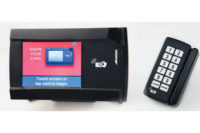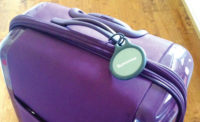Adding Value with RFID, Prox, Contactless Innovations



Enterprises can take advantage of PIV advances with a CIV credential that is technically compatible with the higher level security credential specifications. Security magazine offers a free Webinar on CIV at www.securitymagazine.com.



Beyond physical access control, technology that includes proximity, RFID and contactless smartcards, readers and their system platforms is moving outward to a diversity of business missions.
Obviously, new approaches work well for enterprises looking to improve security or expand their facilities.
That is the case for Long Beach Airport.
Located just 18 miles to the southeast of Los Angeles International Airport is a hidden gem for Southern California air travelers. Long Beach Airport (LGB) serves more than 3.2 million passengers per year and has one of the strictest noise abatement ordinances in the nation for its neighboring residential communities.
Busy Facility but Unique
JetBlue Airways has established the airport as its West Coast hub, while US Airways, Alaska Airlines and Delta Air Lines also provide carrier service. Air cargo carriers such as UPS and FedEx transport 57,000 tons of goods through LGB annually. The airport is also home to the production of the Boeing C-17 military transport jet and maintenance facilities for Boeing and Gulfstream Aerospace. Touted as one of the busiest general aviation airports in the world, a large number of flights originate at the airport ranging from charter to private aviation, flight schools, law enforcement helicopters, advertising blimps and tow planes with advertising banners.
Owned by the city of Long Beach since 1923, it has also been known as Daugherty Field, named after the famous barnstormer Earl Daugherty, who first opened a biplane training school with landings right on the beach. LGB has a main terminal, notable for its circa 1941 streamline modern style architecture. Today, it is a historical landmark. A newer, modern control tower overlooks the west side of the field. Due to the airport’s age and limited size, its passenger concourse area has recently been renovated.
A new $45 million terminal modernization project has taken place at LGB since groundbreaking began in late 2010 to create a new 36,000-square-foot eco-friendly facility.
Upgrading Infrastructure
In addition to the TSA’s security procedures for passenger traffic, the airport’s infrastructure and administrative facilities require complete access control. Commercial Controls worked with PCSC to replace a very outdated system that existed prior to the renovation.
PCSC’s line of IQ Series access control panels are in use throughout the facility, managing doors, passenger gates, elevators and more. HID Global keypads, along with small dome cameras, are some of the visible hardware seen by the public throughout the terminal’s concourse.
The system is securely integrated with enterprise level access control software, LiNC-PLUS. Security and access control of an airport’s facility is a multifaceted situation. It’s complex and should always be adapting to the needs and requirements.
The end-user of the access control software is managed by the Long Beach Airport’s Safety and Security Operations. “Security is a high priority here at LGB and passenger security and safety are taken very seriously,” says John Blood, chief of security and airport safety.
In another application that blends RFID with business needs beyond physical security, software solutions provider AMCS Group helps waste management and recycling companies it serves worldwide to optimize their processes and reduce costs. Thanks to a partnership with HID Global, those customers now benefit from improved data collection, reporting and tracking, which should result in even greater collection efficiencies and enhanced customer service.
Business Basics
The AMCS Group identified a need for durable, reliable RFID technology to provide better real-time tracking and ensure accountability for services provided, as well as to allow faster resolution in the case of trash bin loss or damage. HID worked with AMCS to develop an integrated solution that uses RFID tags and readers to meet the waste collection industry’s challenges of improving efficiency, reducing costs, enhancing customer service and retention and growing the bottom line.
“There has been a huge shift in how the waste management industry manages its business since the introduction of RFID technology,” says Jimmy Martin, chief executive officer with AMCS. “RFID is now an indispensable part of AMCS’ solutions and our future development. Our three main criteria when selecting an RFID tag supplier were durability, quality and responsiveness.”
AMCS deployed HID’s Standard Bin Tags and Plug Tags, custom-designed push-in bin tags for steel containers and OEM reader modules as part of the software solution it provides to municipality and waste collection company customers. When RFID tags are embedded into wheelie bins, readers on collection trucks can identify the container and the system records the weight of the waste it contains. The AMCS system logs the tag’s location and ties it to GPS coordinates. This information is then relayed to the management office to help better guide decisions on route efficiency and fleet optimization. A number of municipal customers also use the RFID technology for recording exceptions such as “missed bin,” “access blocked” and “bin contaminated.”
Technology bridging also can bring higher level security and business benefits to enterprises with legacy mechanical door locks.
One example: Assa Abloy’s Aperio wireless lock family now can include interoperability with Seos credentials from HID Global and the iCLASS SE reader platform. Aperio enables doors to be integrated into an access control system without having to install wiring, make any structural changes to the doors, or modify existing access control credentials or system software.
Then there are other unique RFID applications.
For instance, Elpas, part of Tyco Security Products, has a man-down emergency call transmitter with a holster-worn active RFID tag, which delivers wireless monitoring and tracking of lone workers, prison guards and security personnel who may be subject to attack or injury in high-risk workplace environments.
This article was previously published in the print magazine as "Prox, RFID, Contactless: From Access to Tracking."
Future ID? Follow Airport Use, PIV Evolution and Smart Cards
Identity and credentials are getting more secure and more intelligent, thanks to advances at airports, with smart cards and as PIV or personal identity verification cards move into enterprises with commercial identity verification or CIV cards.
On the aviation side, cards now can include policy-based badge credentialing, TSA compliance, audit, security checks and identity proofing, enrollment and management.
One example: Quantum Secure’s software suite – SAFE for Aviation version 4.5 – an airport physical identity and access management solution that streamlines the lifecycle of physical identities (from on-boarding to terminations) and automates related processes. Such solutions come with pre-defined policies, workflows and procedures for issuing badge credentials, granting/revoking access to airport facilities while simplifying adherence to TSA and FAA regulations, audits and security directives, thus minimizing insider threats and promoting greater operational security.
In another advance, CIV cards are leveraging the infrastructure of PIV cards.
The PIV card is now deployed and used by federal agencies to assign controlled resource access privileges to federal employees and to authorize the cardholder to access both physical and logical resources. The success of this program is largely due to the development of goals, issuance policies and technical specifications that all agencies agree to follow.
Enterprises can also take advantage of this technology. The CIV credential is technically compatible with the PIV-I credential specifications. However, a CIV credential issuer need not comply with the strict policy framework associated with issuance and use of the PIV and PIV-I credentials. Securitymagazine offers a free Webinar on CIV at www.securitymagazine.com.
Further, smart cards are increasingly accepted as the credential of choice for securely controlling physical access. Standards-based smart ID cards can be used to easily authenticate a person’s identity, determine the appropriate level of access and physically admit the cardholder to a facility. Through the appropriate use of contact or contactless smart card technology in the overall physical access system design, security professionals can implement the strongest possible security policies for any situation.
More than one access application can be carried on a single smart ID card, enabling users to access physical and logical resources without carrying multiple credentials. Security can change access rights dynamically, depending on perceived threat level, time of day, or other appropriate parameters. Smart card support for multiple applications allows organizations to expand card use to provide a compelling business case for the enterprise. Smart cards not only secure access to physical or logical resources, they can store data about the cardholder, pay a fee or fare if required, certify transactions and track ID holder activities for audit purposes. Because supporting system components can be networked, shared databases and inter-computer communication can allow separate functional areas in an organization to exchange and coordinate information automatically and instantly distribute accurate information over large geographic areas.
Looking for a reprint of this article?
From high-res PDFs to custom plaques, order your copy today!









